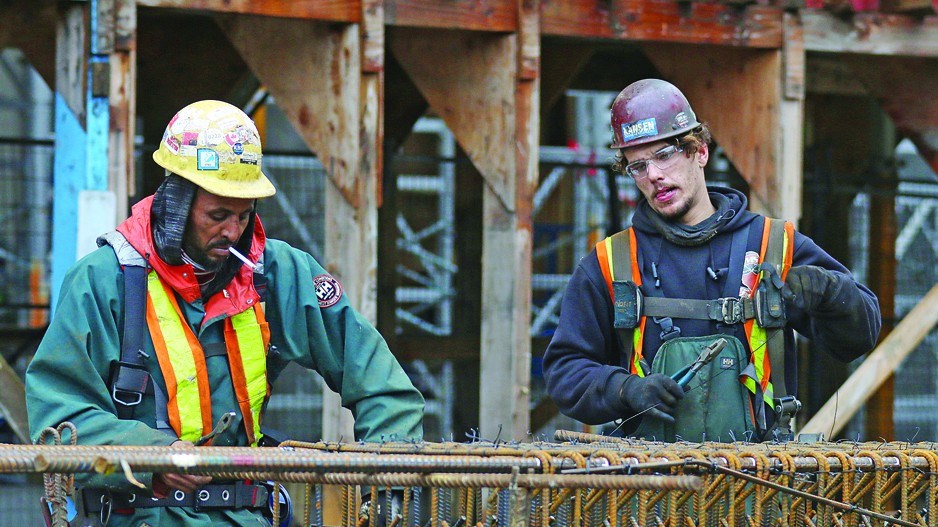Mass-timber buildings on the West Coast – ones eschewing carbon-heavy cement in favour of wood frames – kept hitting a ceiling prior to 2019 as Oliver Lang was seeking to tap the environmentally friendly building material for bigger projects.
“When we started out, you couldn’t really do mass-timber buildings in B.C.,” said the founder and CEO of Vancouver-based construction firm Intelligent City Inc.
Other than a pilot project at the University of British Columbia, mass-timber buildings could never go higher than six storeys before proponents pushed hard for regulatory changes that doubled the storey count to 12.
Those changes pushed Intelligent City on its current path towards mass production of greener construction options within an industry not known for environmental sustainability. Other B.C. companies are also jumping on board as demand grows for green construction opportunities.
Intelligent City officially launched its mass-timber assembly plant last month in North Delta, tapping software and robotics to address three major problems plaguing housing construction: climate change, affordability and supply.
Robotic arms at the new factory are now working on mid-to-highrise home and office mass-timber building projects, the first of which is set to be deployed in Vancouver next year.
The global construction sector accounted for 38% of carbon emissions in 2019, according to United Nations Environment Programme estimates released last year, and other efforts to reduce the sector’s environmental impacts are broadening across the local economy.
Nexii Building Solutions Inc. revealed in September that it had raised $45 million from investors. The fundraising round pushed the Vancouver-based company’s valuation up to $1.55 billion. Nexii said it’s the fastest startup in Canada to ever reach “unicorn” status following its founding in late 2018.
The construction firm is best known for developing Nexiite, a building material that can be used as a low-carbon alternative to cement and concrete for floors, walls and roofs.
Cement’s large carbon footprint results from the large amount of energy used in its production. About 900 kilograms of CO2 is produced for every tonne of Portland cement, according to a 2018 study published in Science Direct.
Materials that have similar properties as cement but lower carbon intensities are being pursued as a way to decarbonize the construction sector.
And as the heat dome and wildfires hit B.C. hard over the summer, Nexii vice-president Gregor Robertson told BIV that market demand for lower-carbon buildings has been soaring.
“We anticipate huge growth with that product in mid-to-highrise buildings, which need to be more far more energy efficient.”
He added that the company also sees opportunities with multi-unit residential buildings.
The company has been striking deals with quick-serve restaurants like A&W Food Services of Canada Inc. and Starbucks Corp. (Nasdaq:SBUX) to provide materials that can reduce buildings’ emissions in some cases by 30%. Two manufacturing plants are operating in North America and six others are under development.
“We’re very focused on growth and scaling across North America currently before we go global,” Robertson said.
But there will be short-term costs associated with the construction sector’s efforts to go green.
An October 2021 RBC Economics report cited studies from the Canada Green Building Council and WSP Global Inc. (TSX:WSP) that estimated upfront costs for a national Net Zero buildings plan would add 8% to the average construction bill.
Canada’s ambition is to reach net zero by 2050, whereby the economy either does not emit carbon or can offset all emissions.
“Finding ways to make the returns accrue more quickly or spread costs over the life of the equipment (for example, with lower electricity rates for those who slash emissions) could accelerate adoption,” the RBC report stated.
“The added annual costs to bring both residential and commercial buildings to Net Zero could be about $5.4 billion a year.”
Meanwhile, Lang said other jurisdictions are also changing their mass-timber buildings regulations to allow for larger structure with smaller environmental impacts.
“We can’t just apply this in B.C.,” Lang said, referring to Intelligent City’s business model.
“Our technology really needs to be scalable into other markets as well. So now we have adoption of that mass-timber code in Alberta. In Quebec, it’s being adopted. We assume it will be done by the end of this year in Ontario … In Washington, Oregon and California, there we can even go with our systems 18-storeys tall because they’ve adopted the International Building Code.”
The company’s proprietary software is integrated with its design and manufacturing systems.
Developers submit a questionnaire about what they want from the building, while the software takes into consideration local building codes and regulations. A digital twin is constructed, which vendors in the building’s supply chain can review to ensure pricey change orders don’t plague the project.
Depending on the municipality, the entire design process may take around three months for a typical building. Intelligent City’s robotic arms are then put to work at the plant, constructing the building’s superstructure and exterior envelope enclosure to be delivered to the construction site.
“The industry applies essentially a service and labour to a commodity,” said Lang. “We picked a completely different approach. We take a product- and platform-based approach, where all our components are tested, fully understood.” •




